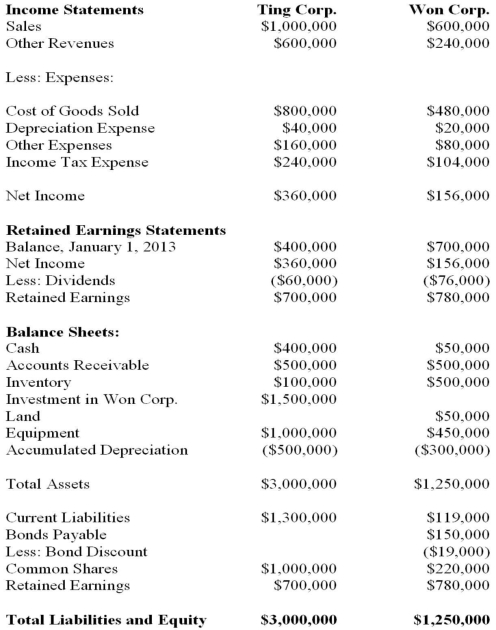Ting Corp. owns 75% of Won Corp. and uses the Cost Method to account for its Investment, chapter) for the Year ended December 31, 2013 are shown below:  Other Information: ▪Won sold a tract of land to Ting at a profit of $20,000 during 2013. This land is still the property of Ting Corp.
Other Information: ▪Won sold a tract of land to Ting at a profit of $20,000 during 2013. This land is still the property of Ting Corp.
▪On January 1, 2013, Won sold equipment to Ting at a price that was $20,000 lower than its book value. The equipment had a remaining useful life of 5 years from that date.
▪On January 1, 2013, Won's inventories contained items purchased from Ting for $120,000. This entire inventory was sold to outsiders during the year. Also during 2013, Won sold inventory to Ting for $30,000. Half this inventory is still in Ting's warehouse at year end. All sales are priced at a 20% mark-up above cost, regardless of whether the sales are internal or external.
▪Won's Retained Earnings on the date of acquisition amounted to $700,000. There have been no changes to the company's common shares account.
▪Won's book values did not differ materially from its fair values on the date of acquisition with the following exceptions:
▪Inventory had a fair value that was $50,000 higher than its book value.
▪A patent (which had not previously been accounted for) was identified on the acquisition date with an estimated fair value of $20,000. The patent had an estimated useful life of 5 years.
▪There was a goodwill impairment loss of $10,000 during 2013.
▪Both companies are subject to an effective tax rate of 40%.
▪Both companies use straight line amortization exclusively.
▪On January 1, 2013, Ting acquired half of Won's bonds for $60,000.
▪The bonds carry a coupon rate of 10% and mature on January 1, 2033. The initial bond issue took place on January 1, 2013. The total discount on the issue date of the bonds was $20,000.
▪Gains and losses from intercompany bond holdings are to be allocated to the two companies when consolidated statements are prepared. Ignoring taxes, what is the total amount of unrealized profits in inventory at the end of 2013?
Definitions:
Leader-Follower Relationship
Focuses on the dynamic interactions between leaders and followers, including trust, influence, and the exchange of benefits.
Heifetz
A scholar known for his work on adaptive leadership, which emphasizes the importance of leaders encouraging adaptation and learning in the face of change.
Virtue-Based Theories
Ethical theories that focus on the moral character of individuals and the virtues they embody for ethical decision making.
Conduct Of Leaders
This term addresses the actions, behavior, and ethical practices of individuals in leadership positions and their impact on their followers and organization.
Q2: <img src="https://d2lvgg3v3hfg70.cloudfront.net/TB2504/.jpg" alt=" The
Q11: The risk exposure resulting from the translation
Q18: LEO Inc. acquired a 60% interest in
Q33: The treasurer typically is responsible for raising
Q36: Tae Franklin is the sales manager of
Q40: <img src="https://d2lvgg3v3hfg70.cloudfront.net/TB2504/.jpg" alt=" The
Q48: A controller is normally involved with preparing
Q52: Another term for product cost is cost
Q95: The area under the graph of
Q102: As the level of confidence increases the